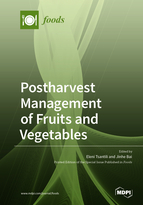Postharvest Management of Fruits and Vegetables
A special issue of Foods (ISSN 2304-8158). This special issue belongs to the section "Food Quality and Safety".
Deadline for manuscript submissions: closed (31 December 2021) | Viewed by 59096
Special Issue Editors
Interests: ripening physiology; pre and postharvest fruit treatments; storage; abiotic stress; ethylene; phytochemicals; texture; quality
Interests: postharvest plant physiology; postharvest handling and storage of fruit; packaging; controlled atmosphere; modified humidity (MH) packaging; edible coating; volatile flavor
Special Issues, Collections and Topics in MDPI journals
Special Issue Information
Dear Colleagues,
The postharvest area of fresh fruit and vegetables (F&V) covers an important part of agriculture. It aims to maintain safety and quality of the products and reduce losses—approximately one-third of all fruit and vegetables produced globally is lost during postharvest process. Environmentally friendly agents and techniques and efforts for energy saving must be considered.
Although the basic steps for F&V remain the same, the development and implementation of new technology is promising to further improve quality and extend postharvest life. However, emerging technology needs deeper information regarding the mechanisms underlying the physiology, biochemistry, and molecular biology of postharvest ripening and storage.
Original articles or reviews with new findings including but not limited to the following topics are welcome:
- Harvesting, pre- and postharvest treatments for F&V quality;
- Ethylene, ripening physiology and technology;
- Biochemical alterations, quality determination, nutritional value, and consumer-perceived quality;
- Physiological disorders and decay;
- Packaging and packing lines;
- Controlled and modified atmospheres;
- Degreening and ripening;
- Novel materials and/or technologies in postharvest area.
Prof. Dr. Eleni Tsantili
Dr. Jinhe Bai
Guest Editors
Manuscript Submission Information
Manuscripts should be submitted online at www.mdpi.com by registering and logging in to this website. Once you are registered, click here to go to the submission form. Manuscripts can be submitted until the deadline. All submissions that pass pre-check are peer-reviewed. Accepted papers will be published continuously in the journal (as soon as accepted) and will be listed together on the special issue website. Research articles, review articles as well as short communications are invited. For planned papers, a title and short abstract (about 100 words) can be sent to the Editorial Office for announcement on this website.
Submitted manuscripts should not have been published previously, nor be under consideration for publication elsewhere (except conference proceedings papers). All manuscripts are thoroughly refereed through a single-blind peer-review process. A guide for authors and other relevant information for submission of manuscripts is available on the Instructions for Authors page. Foods is an international peer-reviewed open access semimonthly journal published by MDPI.
Please visit the Instructions for Authors page before submitting a manuscript. The Article Processing Charge (APC) for publication in this open access journal is 2900 CHF (Swiss Francs). Submitted papers should be well formatted and use good English. Authors may use MDPI's English editing service prior to publication or during author revisions.
Keywords
- fruit and vegetables
- ripening physiology
- storage methods
- transportion
- degreening
- texture
- quality








